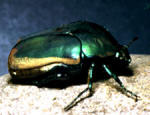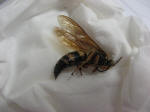 Green June bugs are also called fig eaters. This is because they
can eat soft-fleshed fruits such as grapes, plums, peaches and
apricots. In their larval stage they are a grub, but they don't
do a lot of turf damage like the normal June bug. They tend to
be in places high in organic matter, such as flower beds,
gardens, compost piles and under shrubs, so the grubs aren't
turf pests. Green June bugs are also called fig eaters. This is because they
can eat soft-fleshed fruits such as grapes, plums, peaches and
apricots. In their larval stage they are a grub, but they don't
do a lot of turf damage like the normal June bug. They tend to
be in places high in organic matter, such as flower beds,
gardens, compost piles and under shrubs, so the grubs aren't
turf pests.
 As for control, there is probably none necessary
unless you need to protect those soft- fleshed fruits. Then you
should follow the recommended spray program so you don't cause
problems with the fruit later on. The green June bug doesn't
sting or bite, so you can put them in the nuisance pest
category. The main damage they can do is fly into you, and that
can hurt. On the bright side, you are probably already
protecting things of value from the Japanese beetles, so you may
be covered. As for control, there is probably none necessary
unless you need to protect those soft- fleshed fruits. Then you
should follow the recommended spray program so you don't cause
problems with the fruit later on. The green June bug doesn't
sting or bite, so you can put them in the nuisance pest
category. The main damage they can do is fly into you, and that
can hurt. On the bright side, you are probably already
protecting things of value from the Japanese beetles, so you may
be covered.

Cicada killer wasps
 The cicada killer wasps will return shortly. They are
actually considered beneficial insects because they control
cicadas and katydids. This wasp gets its common name due to the
fact that it hunts and supplies its nest chambers with a cicada,
which becomes a food source for the young wasp. Cicada killers
are a nuisance pest, especially when nesting in large numbers in
a play area or near the house. People get concerned because the
cicada killers resemble giant yellow jackets. The cicada killer wasps will return shortly. They are
actually considered beneficial insects because they control
cicadas and katydids. This wasp gets its common name due to the
fact that it hunts and supplies its nest chambers with a cicada,
which becomes a food source for the young wasp. Cicada killers
are a nuisance pest, especially when nesting in large numbers in
a play area or near the house. People get concerned because the
cicada killers resemble giant yellow jackets.
Cicada killers are about 2 inches long and black to red, with
yellow banded markings on the abdomen. The head and transparent
wings are reddish brown. They are not dangerous, but they are
intimidating. Cicada killers are solitary wasps, with the female
digging a 6- to 10-inch burrow (one-half inch in diameter) in
the ground. A pile of soil typically surrounds the entrance. The
female locates and stings a large insect such as a cicada or
katydid and then brings it back to the burrow. She places the
insect into a chamber and lays an egg on it; sometimes she puts
two in a burrow but lays an egg on only one. She then covers the
burrow, digs another and repeats the process. The egg hatches
into a grublike, legless larva that consumes the paralyzed
insect. Full-grown larvae overwinter in the burrow, pupate in
the spring and emerge as adults during the summer, usually in
July and August.
[to top of second column]
 |

Cicada killers are unlikely to sting a person. Wasp and bee stingers
are modified egg-laying devices (ovipositors), so males are not able
to sting. Females may sting if crushed, either by being stepped on
with bare feet or grabbed with bare hands.
Cicada killers are more common in areas with bare soil, so
mulching, planting ground covers or putting down sod can reduce
problems. Applying permethrin or Sevin (some suggest the Sevin dust
gives better control) to the burrowed area should kill females in
high-traffic areas. Once females are gone, males leave. In home
yards, sandboxes can be covered with a tarp when not in use, as this
deters the wasps (and also keeps cats out). Sand below swings,
jungle gyms or other playground equipment is a popular site for the
cicada killer. Raking the sand may discourage the wasps, or you
could use mulch instead of the sand. In extreme nuisance situations,
treatment of burrowing areas with a pyrethroid insecticide or
carbaryl may reduce problems.
Japanese beetle update
Numbers of Japanese beetles continue to increase. Trap captures
have doubled in the last week. This would indicate peak emergence is
at least 10 days to two weeks slower than normal. It also means the
beetles will be with us for a longer time. The extended time means
probable feeding through the end of August, with some beetles
present until frost.
[By
JOHN FULTON,
University of Illinois Extension, Logan County]

 |